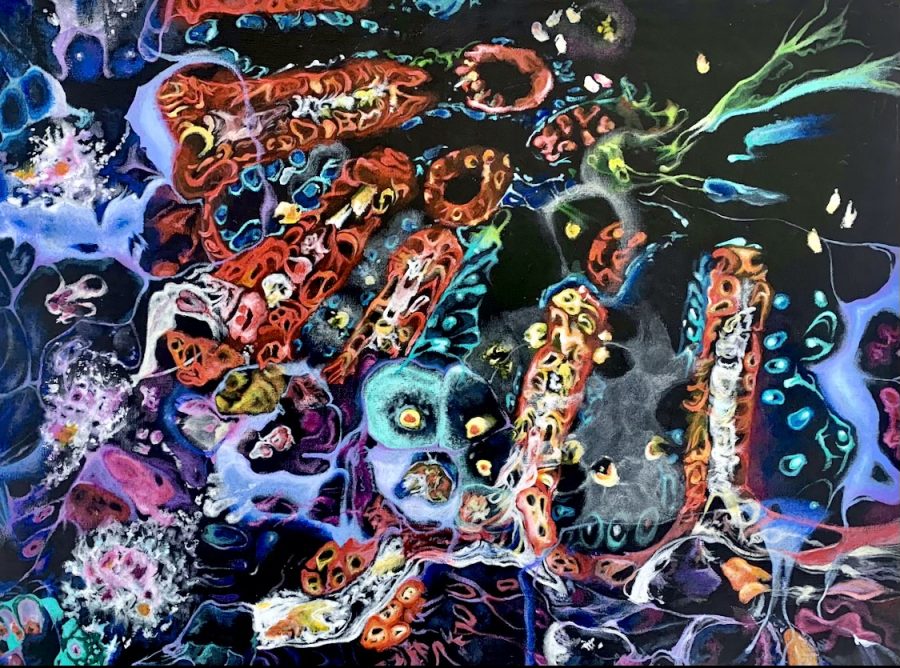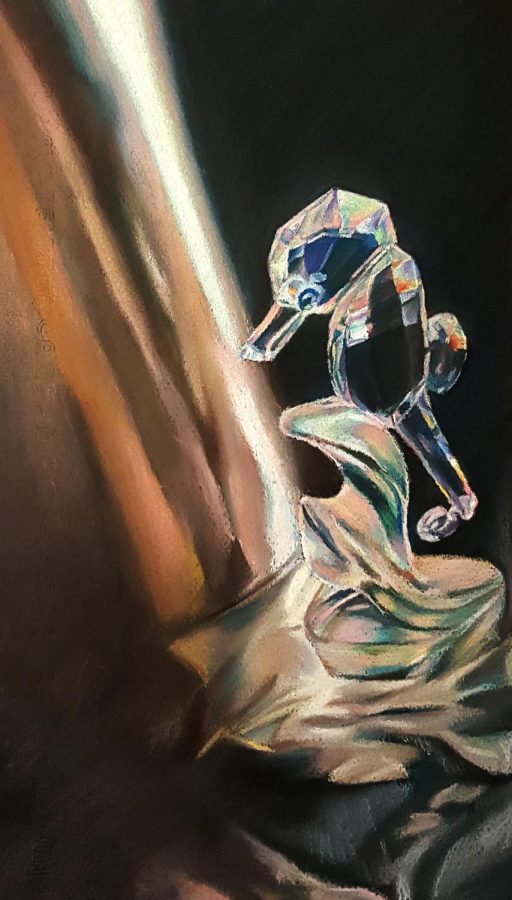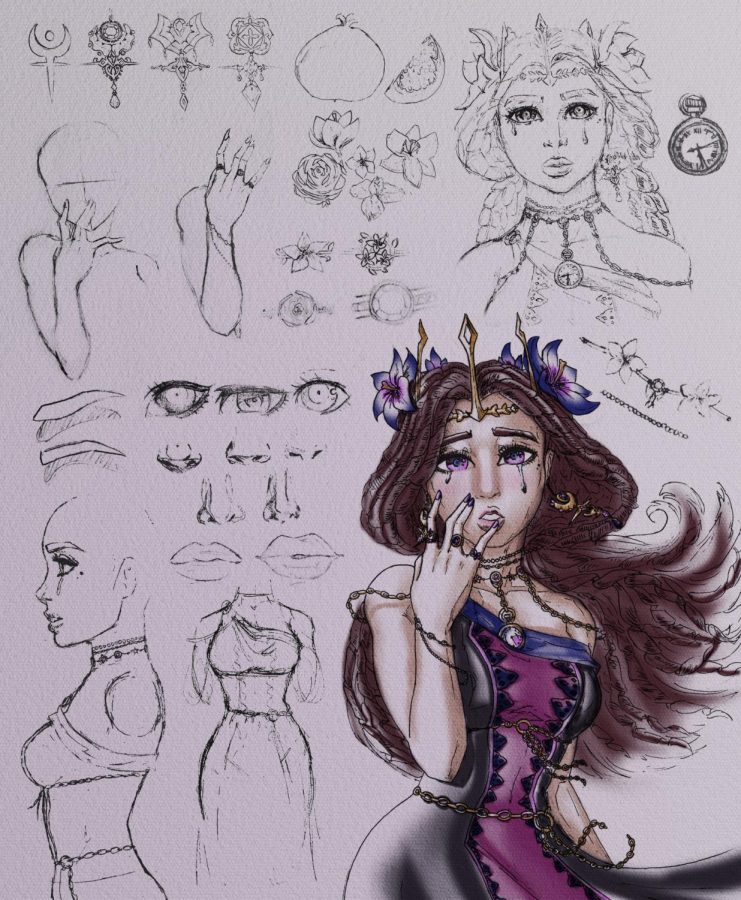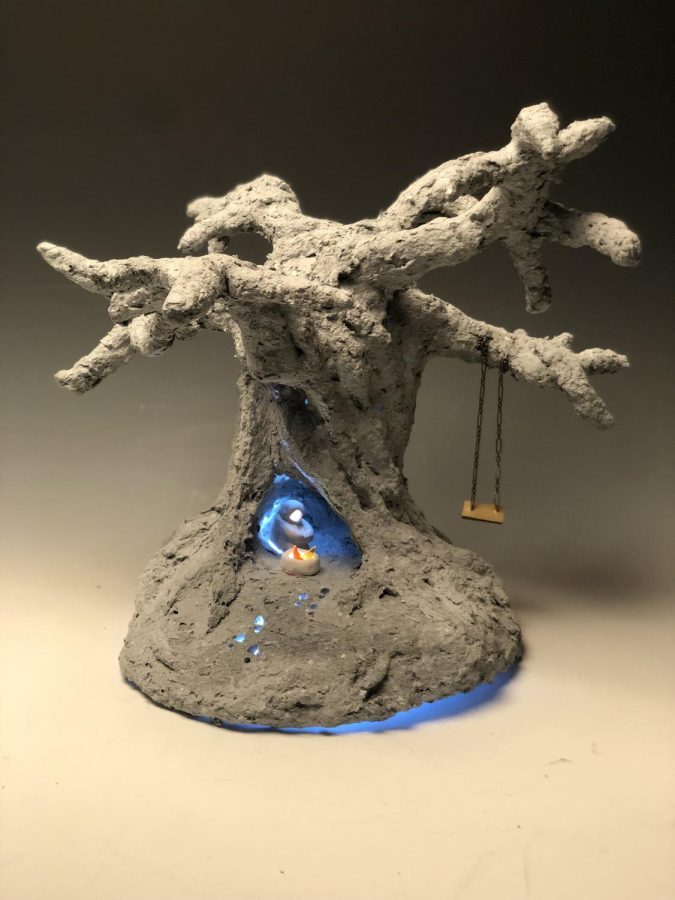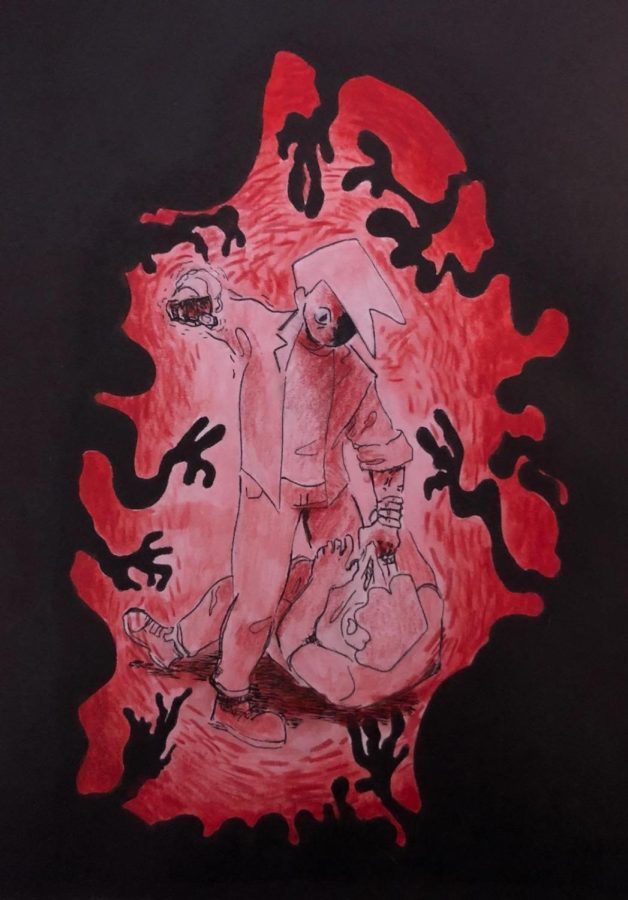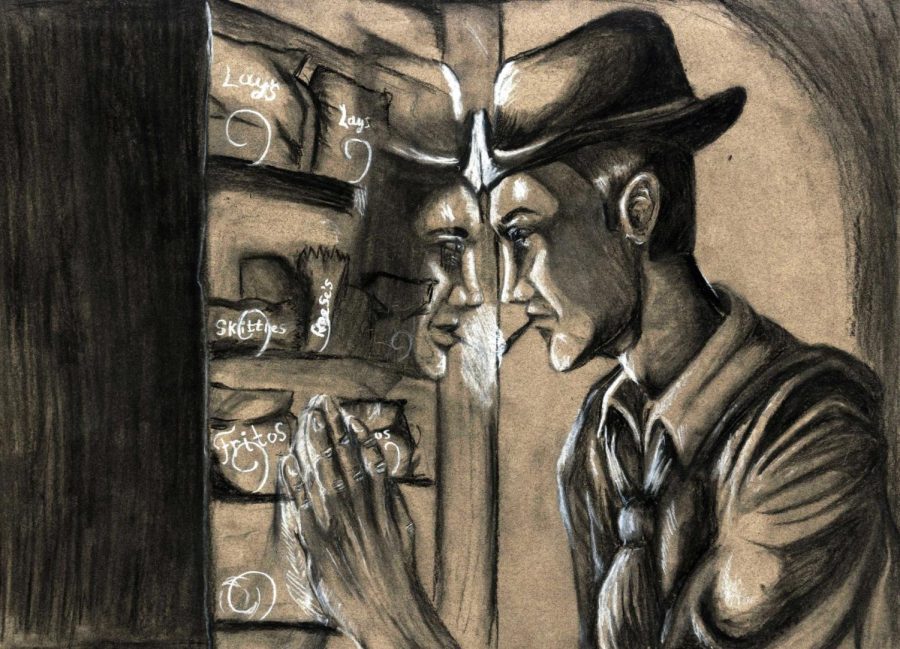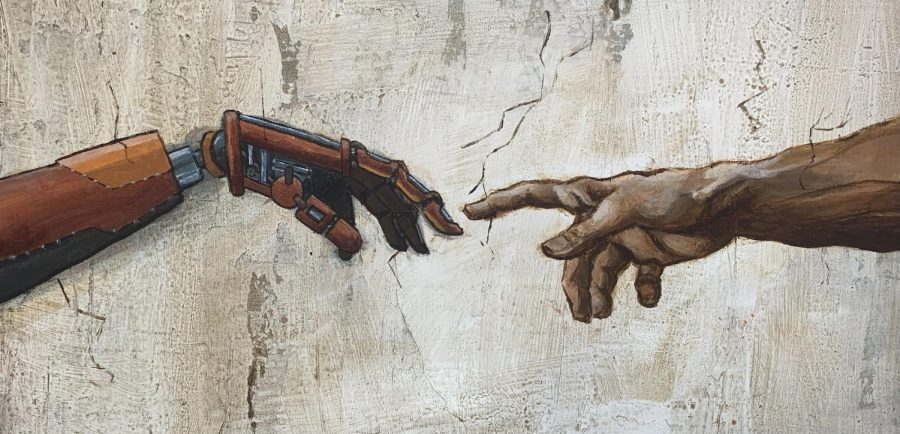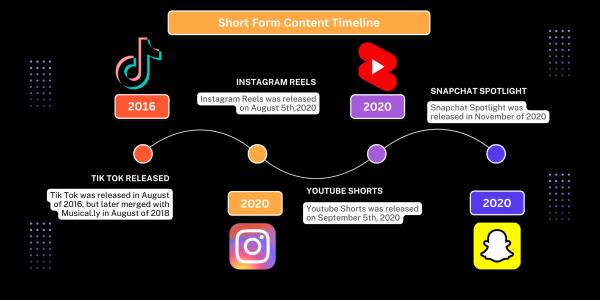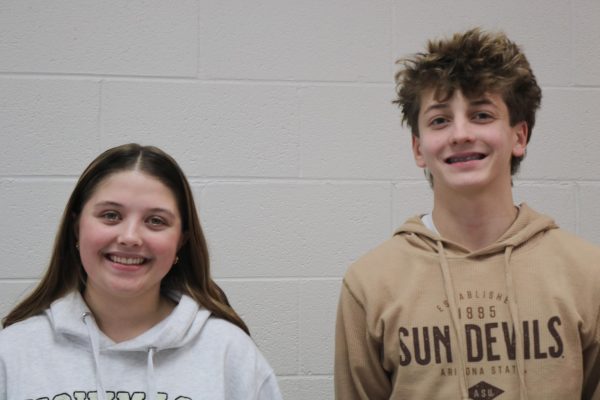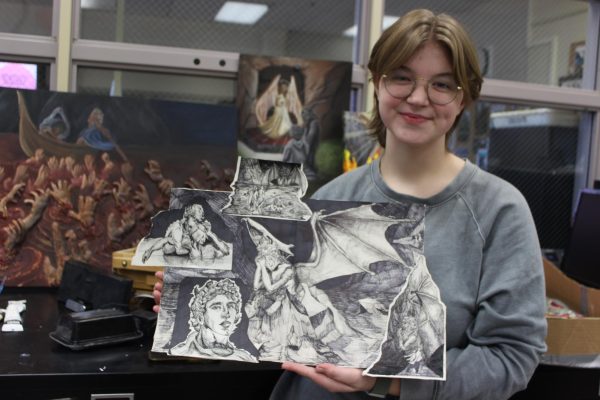The AP Portfolio: Creativity Brought to Life
Each year, students from the three sections of AP Portfolio (AP 2-D/Photography Art and Design, AP 3-D Art and Design, and AP Drawing), submit their work to be judged and graded as their final AP project. In this year-long project, students have to conduct a sustained investigation in which they answer a question through their artwork, as well as write descriptions explaining and connecting each piece to one another and to their sustained investigation. AP Portfolio gives students the chance to pursue a concept using different mediums, and then express their art through their finished products and written responses. From sculptures, to acrylic paintings, to jewelry, or even scratchboard, artists deeply connect with their art through AP Portfolio.
Kaitlyn Mitchell
What is your sustained investigation about?
“I have Celiac, which [means] I can’t eat gluten. I share about how my allergy affects me on a day to day basis. Not only how it affects me daily, [but] how it affects me on the inside and mentally.”
What has been your favorite piece to work on so far?
“Personally, my favorite piece was a cardboard piece where I had to use a cross hatching technique and then use fabric and other pieces of cardboard to demonstrate how the food I ate tasted like cardboard sometimes.”
When it came to learning new art techniques, did you learn them on your own or did your art
teacher help you?
“I mainly learned them independently or used what I already knew. But my art teacher has a bunch of art books, so he gave me one on Henri Toulouse, and I learned to develop that sense of Impressionism which was really fun.”
Why do you think it’s important for people to know your condition through your artwork?
“I just think that it’s not only me with the allergies, but just other people with conditions like this can possibly feel
like it’s a joke to other people. Sometimes I find it funny when people make jokes and it is part of my personality
sometimes. But overall, it is important to show and realize that there are deeper meanings behind these [works of
art] and it’s important to show the processes that you have to go through to even get diagnosed.”
Gwen Edgar
What was your sustained investigation about?
“I chose to do my sustained investigation about light.”
What kind of mediums did you use?
“I experimented [quite] a bit with chalk pastel. I drew on sandpaper for two pieces. I also mixed chalk pastel with water and did that for two pieces.”
What was it like doing AP Portfolio remote last year? What about art supply issues?
“I will mention that during COVID, if we wanted art supplies we could ask to get them at a drop off area. So I got more paper [and] I got more chalk pastels that way.”
What did you think about the sustained investigation?
“I liked it. It meant that you were forced into a corner, but at the same time, you could change your [sustained investigation topic] if you really needed to. It also gave you some direction. In other classes, they [might] say ‘write about anything,’ and you’re like, ‘What do I do then?’ So, it helps you figure out what you’re going to do. That’s always really nice.”
What was your favorite aspect of AP Portfolio?
“I like that we got to choose our own thing in terms of what we did. Some people said, ‘Ooh, I’m gonna design my own world for a video game,’ and such. I always thought that was really cool.”
Grant Giardina
What is your sustained investigation about?
“I chose to investigate the process of creating 3-D models to depict Greek Mythology.”
What did you decide to do as one of your first pieces?
“I want[ed] to start with something more humanoid [for a piece], just to get better at making people and not starting off with something too complicated. I chose the goddess Persephone. I began by researching her origins and character design. I wanted to focus on the aspect of her role as a goddess as well as what she went through.”
What’s one way you added detail into the piece?
“She was abducted by Hades while picking flowers. I researched what types of flowers she was picking at the time, and what I eventually settled on were crocuses, the flower that lured her into being captured. I decided to cover her jewelry and adorn her hair with them.”
What’s the process you’ve gone through to create your final products?
“It starts with 2-D sketches and goes through Photoshop a bit in order to compile different elements, [which is] mostly just for presentational purposes. For the actual 3-D model, I use the Blender 3-D modeling program.”
Jonathan Haug
What is your sustained investigation about?
“My sustained investigation is about the relationship between people and nature when in states of emotion.”
What kinds of mediums do you use?
“I’ve started off with a kind of paper mache and using a wire armature, which is like a skeleton [of sorts]. Then I’ve gone into porcelain, stoneware clay, and raku clay, and now, I’m [working with] metal. I’m also going to be mixing that with stone or clay.”
What is raku clay?
“That’s a specific type of clay. You put [a] glaze on it and [after that], we actually invite people to the school and they have a special method of firing it, [which] creates this crackle texture on [the clay]. It’s pretty cool.”
What’s the message you want to convey in your artwork?
“The message that I would convey is to not overlook going on a simple nature walk when in a stressful situation. I think it helps more than you think. I think using nature as an outlet is a great alternative to staying in bed.”
Josie Thomas
What is your sustained investigation about?
“My sustained investigation is the difference between how people deal with stress. [More] specifically, fight versus flight responses and how you can illustrate that in different ways.”
What pieces have been your favorite so far?
“My favorite ones have always been the ones with a combination of ink, watercolor, and gouache because they gave me either very dark colors or very bright and vivid backgrounds.”
What is gouache?
“Gouache is a really, really fun medium, it’s a combination of watercolor and acrylic. Basically, if you take your paintbrush and dip it into the paint, it’ll act exactly like acrylic. If you dip it in water, all of a sudden that dry paint will start moving around like watercolor.”
What are you hoping to accomplish by the end of your second semester?
“I want to be able to establish a really good work ethic for my art because that’s really hard [to do]. If you procrastinate just once, it will set you back months.”
Madison Wilson
What was your sustained investigation junior year?
“My sustained investigation included documenting the sense of timelessness during the pandemic.”
What is your sustained investigation this year?
“Now, I’m working on the progression of time during my senior year, because [I] think being 18 is a key age. I’m trying to capture all of the things happening to me this year so I can decide what really is important in my life by carrying around a camera…”
What kinds of mediums do you use?
“Film photography is my favorite. I’m also experimenting with digital photography, and I’ve also been trying to get back into pastel drawing and painting.”
How do you vary your photos and make them stand out from one another?
“So, I started out with just changing the subject matter. I switch between landscape and portraits of people and animals. I also started experimenting with contrast, [and making] more contrast than in other photos.”
Chris Giamis
What is your sustained investigation about?
“It’s about types of theater in mundane situations. I take a historical or modern approach to theater and I place it in a boring scenario. An example would be a clown taking home groceries and stuff like that.”
What kinds of mediums do you use?
“I used acrylic for the majority of the semester. I also used charcoal. This semester, I’m working on scratchboard, which is a blank sheet of paper and you scratch away the black to reveal white. It makes for a really interesting light source.”
Do you have a favorite medium?
“I tend to like black and white because I just think I’m better at it, [as] I can get more detail [using black and white] than color. I tend to prefer things like charcoal and ink, but I did start out with a lot of acrylic because my theme tends to have colorful things because theater is bright.”
What is the process you go through when making your art?
“Usually [I] just start with a sketch or a concept. Then, if I like it, I go into more detail, getting photos so I can make the proportions or the background more realistic. Then, when all of that’s thought out, I finally start the piece using [a] medium of my choice.”
Megan Snow
What is your sustained investigation about?
“It is about an exploration of the interaction of robots and humanity through famous art pieces.”
How have you gone about answering your sustained investigation?
“I’ve been studying robotic components like joints and gears and how things move and I’ve done a lot of research on the human anatomy, especially facial [anatomy] so that I can accurately portray these human figures as androids and cyborgs.”
What has been the most challenging part of incorporating robotic features onto human people?
“Definitely [the] details. I’ve had to figure out how to incorporate new mediums into classical pieces in order to finesse these robotic details that otherwise won’t read if I don’t do them properly.”
Have you ever tried pulling stuff you’ve learned from other classes into your art?
“I would say definitely [in regards to] freshman year geometry. I use a lot of geometry concepts, and it’s how I categorize a lot of things in my brain and how I measure the differences between shapes and distances and plot everything out with my eyes. So I would say that geometry has been a big help.”



